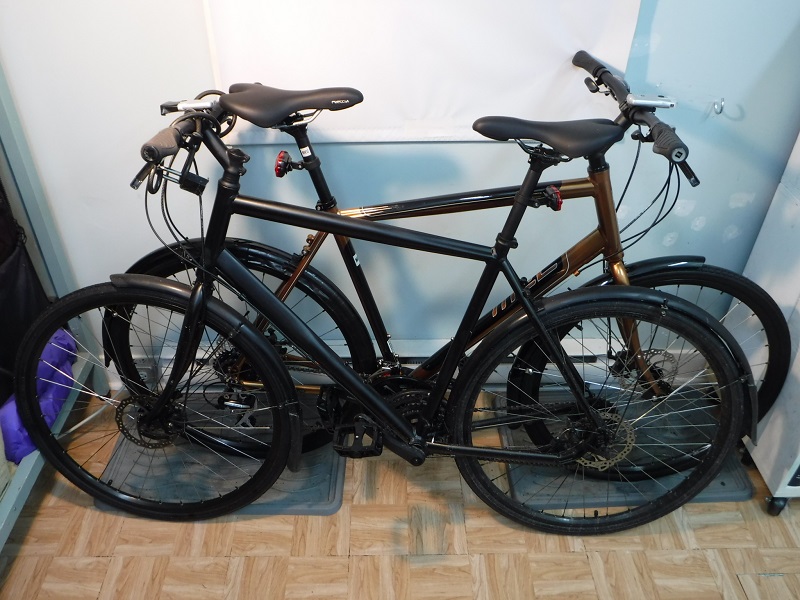
Pair of MEC Chinook urban bicycles.
Let's Adore Jesus-Eucharist! | Home >> Varia >> Bachelor's Kit

Pair of MEC Chinook urban bicycles.
1) Introduction
2) Rationale
3) Requirements
4) The current least-bad bicycle
5) Expensive mistake: Montague Paratrooper with Shimano Alfine
6) My dream bicycle
Sadly, this article is not a description of how to buy or build a good bicycle. Currently, I cannot find a good bicycle anywhere on the Internet (and Lord knows I've looked!), and I cannot modify an existing bicycle to make it satisfactory. The only solution would be building one from scratch, but this requires time, money, tooling and knowledge I currently don't have.
So this article instead describes my current least-bad solution, as well as the dream bicycle I would love to have.
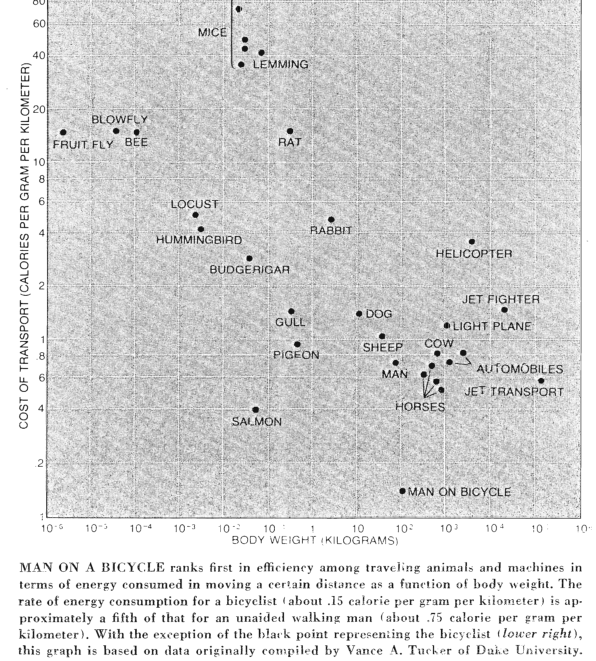
Comparaison of energy consumed in moving a certain distance as a function of body weight.
See among others the Section of same name in The "Hand-truck/Bike Trailer" Combo (French only)
As usual, the requirements for the "ideal prepper's bicycle" start with the requirements for an ordinary bicycle, i.e. a two-wheeled man-powered transportation device. So the bicycle needs to carry one person, be able to tolerate imperfect roads (hence the pneumatic tires which we take for granted but which are an engineering marvel), have low drag (for example, using ball-bearings in the wheel hubs), be lightweight (because all human-powered vehicles are very weight-sensitive), be affordable (because a perfect bicycle that is too expensive to buy cannot be used to transport us!), and so on.
The additional requirements for a "prepper's bicycle" (I guess you could also call it a "military bicycle") all deal with maintaining mobility in harsh conditions (i.e. during a disaster):
3.1) Sealed delicate mechanical parts. First, for non-Canadians, I'll explain the concept of "Winter" a bit. In the wintertime (which in Quebec City seems like 9 months long), the roads are covered with "slush", a semi-solid mixture of snow, water, sand, road salt and dirt (made sticky because it gets mixed with your bicycle lubricants). Riding your bicycle through this stuff will spray abrasives (sand) and corrosives (road salt + water) into every single nook and cranny of your bicycle, in about 10 minutes. (And this is in the best of cases, i.e. you have huge modified mudguards!) In other words, your bicycle will almost immediately start to abrade and rust itself into uselessness. I don't care if you found your bicycle in the garbage, or if you paid five thousand dollars for a high-tech marvel: they will both fall apart just as quickly. Currently, since my dream bike doesn't exist, I manage to ride 12 months a year because I've soldered an additional hot water tap under my kitchen sink, which is connected to a water hose with quick-release fixtures, so I can pressure-wash my bike with hot water on my front porch, after just about every ride. Then I have a fully-equipped shop with workbench and bicycle stand where I give regular (and time-consuming) maintenance to my bike. It can be done, but only by a semi-employed Catholic monk, not by normal men who have normal jobs and kids to raise.
The whole idea of "sealed delicate mechanical parts" will be explained at length in the section on my dream bicycle.
3.2) Three pairs of quick-change wheels (on-road, off-road, ice). Bicycles are human-powered, so any small reduction in efficiency is catastrophic. In a car, if you increase the rolling resistance a bit, you might pay a bit more in gasoline, but that's all. On a bicycle, for the same percentage increase, you might not even be able to move anymore! (Or at least you'll soon be forced to stop because of exhaustion.) Another problem is the difference between static mass and dynamic mass. A pound in your boots is as heavy as six pounds in your backpack. Same thing for a bicycle: a cheap and heavy "rust-bucket" bicycle frame with super-expensive racing wheels will go almost as fast as a super-expensive racing frame and wheel combination, but not the opposite (cheap and heavy wheels on a super-expensive frame). Finally, I think most bicycle wheels are too big. Bicycles are not like cars; when you reach an obstacle with your bicycle, you can just get off, haul up your bicycle to your shoulder, and walk over the obstacle. So very large wheels are not necessary for off-road performance (our legs are the best off-road technology on the face of the Earth). And smaller wheels are much lighter, especially as the tire gets wider (for lower ground pressure to be usable on firmer conditions of mud, snow, sand, etc.), and heavier (if steel-belted radials, which ideally would exist also for bicycles). Most bicycle wheels are roughly 26-29 inches in diameter. I'm thinking approximately 18" would be enough.
Normal on-road conditions require tires that are high-pressure, very skinny, and almost totally slick (i.e. very little tread pattern). That in turn requires special skinny rims.
Off-road conditions are more complicated, because the definition of "off-road" can mean anything from firm grass or gravel, to a vertical wall of granit on Mount Everest, with everything in between including a river flooding into a village like I saw yesterday along the Chaudière (2017-April-17). So the first conclusion might be called the Law of Wheel Compensation: what is removed from the road must be added to the wheels:
- as potholes and bumps get bigger, wheel diameter must get larger (to make
surface irregularities "shrink" relatively to the wheel);
- as ground resistance goes down, tire size must increase and tire pressure must go
down (lower ground pressure, like snowshoes to avoid sinking);
- as ground becomes more slippery, tread pattern must get more aggressive (with
ultimate "aggressiveness" being sharp pointed ice cleats);
- Etc. (By "etc", I mean for example tank tracks, where the vehicule literally
carries a road on its back, and lays that road in front of itself, then after
travelling on that road, it picks it up behind itself and brings it back to
the front, where the cycle resumes. In other words, the "road" is completely
integrated into "the wheel".)
The second observation could be called the Law of Vehicular TNFL (There Is No Free Lunch), i.e. no matter how big the wheel, or how low the ground pressure, or how grippy the treads, most off-road conditions are too off-road to be rideable, and the remaining small minority of off-road conditions impose such a weight and rolling resistance penalty that they basically are also unrideable. This Law basically means we need roads, and nothing can ever really compensate for a non-existant road.
Despite the Law of Vehicular TNFL, it is possible to allow a bit of off-road capability for a bicycle. Normal road wheels for example will sink, like a pizza cutting rotary knife, into sand, loose gravel, wet soil, etc., whereas those conditions are quite frequent. So it makes sense to have a set of off-road wheels for such conditions.
If I could find a way of imitating retractable cat claws in a bicycle tire, we would not need a third set of wheels with ice cleats or spikes. The specific problem with ice is that it's very common on roads in the Winter, and very dangerous, and special Winter tires with very small "nails" or "cleats" really work wonderfully well. (I do remember riding around one night after icing rain, and thinking it can't be that slippery, since things are going so well. So I tried to step off my bike and walk a bit, but it was so slippery I climbed back on my bike as quickly as I would have climbed back aboard a life raft after seeing sharks swim around! Wow! Those brand-new ice tires really worked!) The second problem with ice is it's often combined with sections of the road which are on asphalt and concrete (i.e., no ice), which quickly abrade the ice spikes into uselessness. So you cannot just install your Winter tires at the beginning of the Winter and leave them on. You have to put them on just when you need them, then remove them and replace normal tires. Hence the third set of wheels.
The ultimate way of testing all this would be to build a bicycle with such sets of wheels, then have timed trials: one rider is allowed to carry spare wheels strapped to his back, the other not. So you can find out in what conditions it begins to pay off to carry the extra weight of another set of wheels, and take the time to change them. Since portaging is always possible, I suspect very short sections of off-road conditions would not justify carrying an extra set of off-road wheels. But after a certain distance of portaging (50 meters? 200?), the guy who stopped to switch wheels would win the race. (Also keep in mind this "magical" bicycle has quick-change wheels, i.e. no playing around with the chain to change the back wheel; it's just pop-off and pop-on, no fuss).
3.3) Low maintenance and easy repairs. Ideally, apart from putting air in the tires and oil in the oil reservoir, there should be little maintenance to do. Also ideally, with a few simple tools, the whole bicycle should be easy to take apart and fix.
3.4) Puncture-resistant tires. My most frequent mechanical breakdown over the years has been plain old tire flats. I think "puncture-proof" is impossible, but common problems like broken bottles of beer along the road should not cause flats. Think about some disasters you've seen on TV, and you will not picture nice perfectly clean streets! I'm assuming the road wheels would not be puncture-resistant, but the off-road wheels would ideally be steel-belted radials.
3.5) A bit of "stealth". If possible, no rattles or glares (no noise while riding or hitting bumps, and no reflexive surfaces). It's also nice if the bicycle doesn't attract attention (i.e. it must not look expensive).
3.6) Mudguards. OK, this might be more of a personal mania, but I can't live without huge mudguards. Ideally, mudguards would only be useful because they keep you clean and dry. Unfortunately these days, mudguards are also necessary to try to protect the transmission.
3.7) Compact storage. I find myself glad I can easily fit my bicycle in a car trunk or in a closet. It's nice when the bicycle can complement the car: drive as far as you can, then take out your bicycle, unfold it, and go the rest of the way on bicycle.
Some "non-requirements":
3.10) Road racing. Any features designed for bicycle road races are pretty useless on a more military bicycle: skinny high-pressure wheels (the less perfect the road, the more useless they become, unless you can switch them out for off-road wheels), many closely-spaced speeds (maintaining a very regular pedaling pace is not important to us, so a few speeds are plenty), very aerodynamic position on the bicycle (i.e. crouched down very low while pedaling), very expensive components to be as light as possible, etc.
3.11) Suspension. A mountain bicycle racing downhill off-road quickly becomes uncontrollable without at least a good front suspension. A more "military" or "prepper" bicycle is not used for racing downhill. In a disaster situation, you don't want to risk breaking bones just for the thrill of "catching air" while going really fast downhill. You will tend to just get off your bicycle and walk or portage in dangerous parts of the way. So suspension, front or rear, is just more weight and more fragile stuff that requires maintenance and that can break when you least want it to.
3.12) Tires with lugs. For city cycling, even in the Winter, I think tire with lugs are more of a disadvantage. Many years ago, for some silly reason, I switched to "city slickers" in the dead of Winter. What a massive improvement over tires with aggressive treads! Yes, it was a bit more slippery, but the rolling resistance was so much reduced that I've never again used tires with big lugs. Of course, if you have quick-change wheels then you can have big lugs when you need them, and slick road wheels otherwise.

On my way to an interpretation contract, 7h15, -19 Celcius.
Shortly before Easter 2017, I finally threw in the towel and gave up on my very expensive mistake, the Montague Paratrooper. Instead I purchased two (yes, 2, on the same day) MEC Chinook bicycles. It's a bog-standard urban bicycle: 700mm wheels, no suspension either front or rear, plain external derailleur front and back, ordinary disk brakes (not hydraulic, just plain cable), no carbon fibre parts. The only modifications (so far) were to throw away the MEC Moss pedals (fine for normal use, but when weather is really cold and wet, they become slippery like banana peels) and replace with MEC GnT pedals, throw out the crappy "Selle Royale Freccia" (which cause me horrible pains in the unmentionable male parts) to replace them with just about any modern bicycle saddle with "anatomical relief" (all the inexpensive MEC saddles have this; why the blinkedy-blink did they put a crappy saddle on this bike?), drill out the rims so ordinary Schraeder valves would fit (for some reason, I never liked Presta valves. I also find it hard to justify two different valve systems for hand truck, bicycle, car, etc. Why not Schraeder valves everywhere?), add mudguards, LED lights front and back, and my famous "Nothing-Worth-Stealing-Here®" matte black spray paint job.
Why two? One for Wintertime, one for the rest. (Also really nice when I need to wait for spare parts, or when I have a long repair I cannot do right away). Both bicycles together cost me less than one of my previous bicycles (at the time I purchased them, only children's bicycles were less expensive in the MEC catalogue).
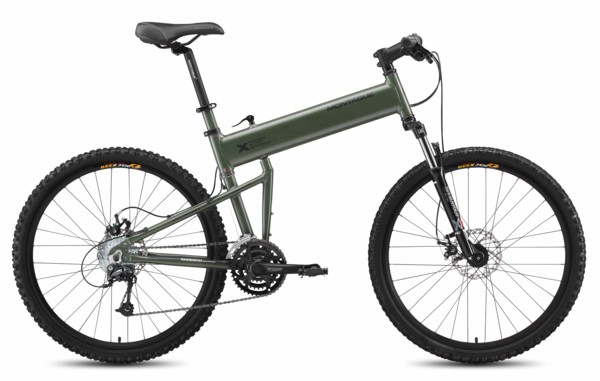
Montague Paratrooper folding mountain bicycle.
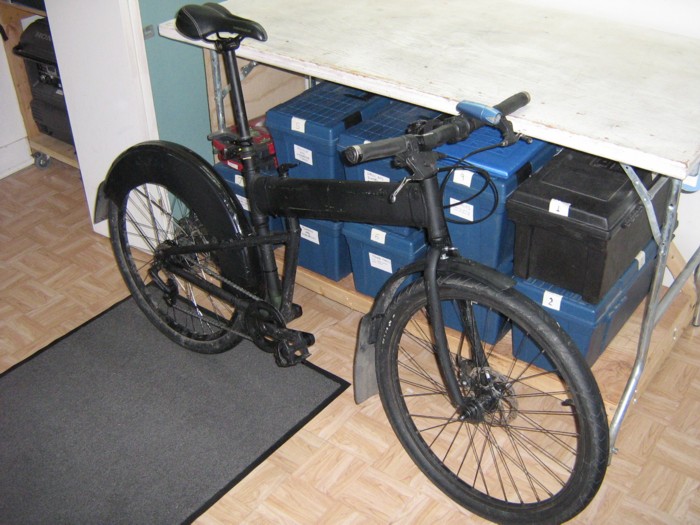
Bicycle, right side.
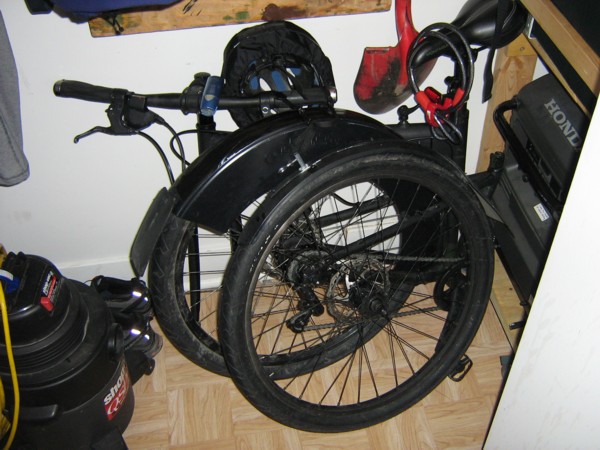
Bicycle folded in closet.
Had I known what I know today, I never would have purchased a Montague Paratrooper. At the most, I would have purchased just the folding frame from that company (they didn't sell them separately when I bought mine). I ended up throwing out and replacing almost all parts except for the folding frame!
Some of the parts I remember throwing out and replacing with better components: useless and heavy front suspension, crappy disk brakes that broke almost immediately, cheap handlebar grips, excessively- short seatpost, lugged tires, crankset, front and back deraillers, shifters (garbage Shimano "rapidfire" trigger shifters), rear rim, etc.
In a desperate attempt to protect the transmission, I paid almost as much as for the whole bicycle to install a Shimano Alfine 11-speed internal transmission (which required a different crankset and a different rear wheel). Was it worth it?
Some positives about the internal derailleur. I agree it's nice to be able to shift gears without having to pedal. I also does remove some of the exposed transmission parts (front and rear external deraillers), which should mean less maintenance. I was afraid of the lower gear ratio spread (an 11-speed is only about 400%, about a third less than an average mountain bike), but I was able to climb the worst hills in Quebec City without any apparent problem. So the Rohloff Speedhub 500/14 14-speed doesn't seem necessary (it's more expensive, harder to find, and I have no idea who would be able to fix it around here).
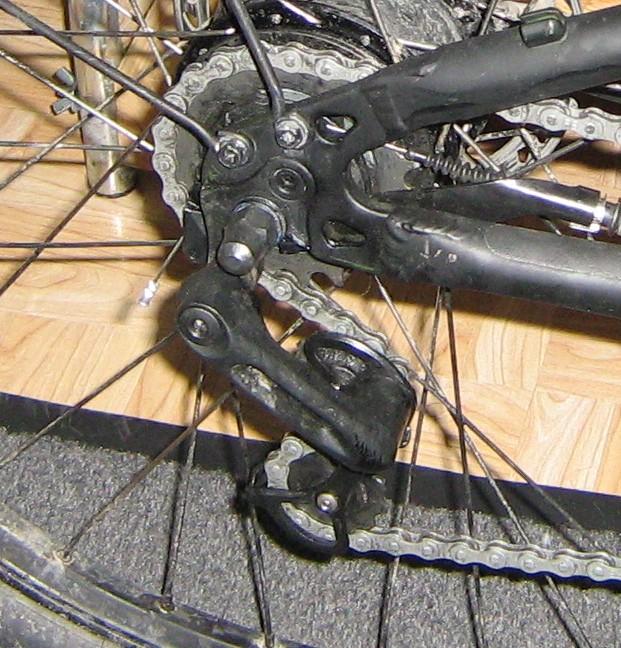
Silly chain tensioner which is required if you don't have a proper frame.
Some disadvantages: very heavy, no idea how to maintain it (apart from changing the oil), requires large wrench to remove (you cannot use the normal quick-detach hubs for the rear wheel, so if you have a flat tire, you have a problem!), etc. Also, the folding frames made by Montague don't let you install an "excentric bottom bracket", which would let you adjust the chain tension. So you need to add part of the rear external derailleur, which negates part of the expected savings in maintenance. I also strongly suspect an internal derailler will never be as efficient as an external derailler (a chain connecting two sprokets is remarkably efficient for transmitting torque), and Lord knows that in all human-powered vehicles, the slightest inefficiency is punishing. Another huge disadvantage is that the chain and two sprokets are still exposed, so the transmission is still destroyed by "Satan's Winter Sludge".
The biggest disadvantage was Winter operation. It worked for a while, then it basically quit. Some speeds continued to work, but most of the high gears remained unavailable during cold days. Even after draining all the oil out and replacing with super-thin industrial sewing machine oil (which is about as thin as water), it still would not work in the cold. Not only that, but it was like playing roulette. You would downshift or upshift once, and you could never know ahead of time if the result would be: (i) a downshift; (ii) an upshift; (iii) nothing whatsoever (pedals spinning like crazy as if the chain had broken); (iv) horrible crunching sounds like coffee beans in a coffee grinder.
I'm glad the local bicycle shop did not have a Gates belt drive, because belt drives don't solve my problems. On top of being expensive and rare as unicorns around here, as well as requiring a special frame that separates since you cannot cut and reassemble a belt like you can with a chain. They won't rust like chains, but they are hopelessly inefficient, on top of being destroyed by the sharp little rocks contained in "Satan's Winter Sludge".

Front mud guard.
The Montague folding mechanism sucks. An immediate problem was that I could not have a normal mud guard on the front wheel, because of the way it folds. I had to jimmy-rig a removable mud guard. I started with a normal mountain bicycle front mud guard, then removed the metal wires normally used to connect it to the fork, then reinforced it with some aluminium bar. I added an extension (I've never seen mudguards long or wide enough available in stores) cut from a water-heater "drip-pan" and attached with nylon "zap-straps". On top, there is a 0.25" coupling nut held with a bolt screwed from below the reinforcing aluminium bar stock. The coupling nut is drilled and threaded, so it can then be bolted to the fork (I used the silly-looking eyebolt because the big "eye" of that bolt lets me screw it by hand).

Main pivot of frame folding mechanism.
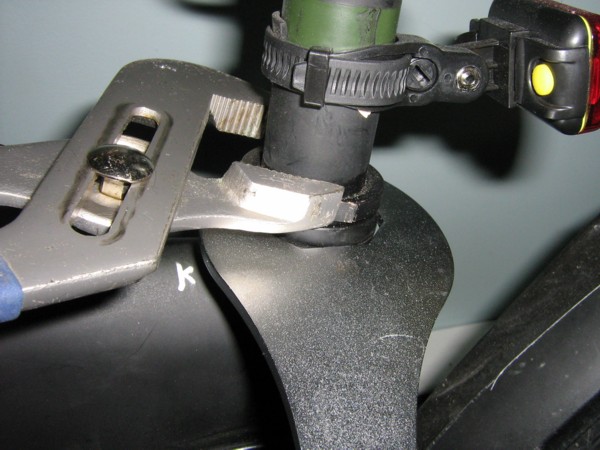
Tightening of main pivot of frame folding mechanism.
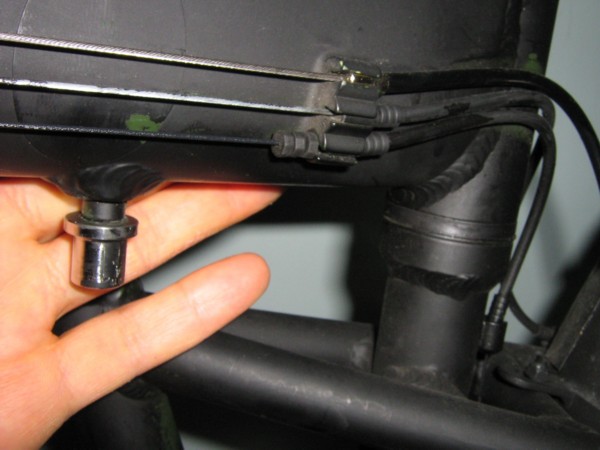
Locking lug for frame folding mechanism.
The actual mechanism to fold the bicycle's frame has so far held out, but I've given it no off-road use (no jumps, etc.). After a few months, strange noises could be heard, and I eventually traced them down to the pivot mechanism of the folding frame. I tightened the main pivot (there are two nuts that can be tightened), as well as the locking lug (by grabbing it with a Vise-Grip and screwing the quick-release lever it's connected to), but none of this was mentioned in the Owner's Manual. Also, an acquaintance of mine purchased the same bicycle a few months after me, and his main pivot is different from mine (I could not find any way to tighten his main pivot). Given the importance of the folding mechanism (the only selling point for this bicycle), I would have assumed the maintenance schedule for that mechanism would have been pretty extensively documented!
The verdict overall for this whole Montague folding bicycle fiasco is: yes, a folding mountain bicycle is a great idea, but no, this particular implementation of that great idea is not good. Some reasons why:
- Folding is so fussy you never do it unless you have to. Since I have a small
appartment, I deamed of a bike that could be folded away and left in my closet
or something, but eventually it just stayed out there in the way like my normal
bike, because it was to fussy to fold and unfold.
- Heavy. Yes, it's not a super-expensive bike, so that had to be expected, but
still, my new MEC bike is less than half the price and much lighter...
- Weak. Even if I never used it as a real mountain bike, still the folding
mechanism caused problems.
- Even when the folding mechanism came in handy (for example to put the bike in
the trunk of the car), I still would have preferred a disassembly mechanism
rather than a folding mechanism. Folding a bike doesn't make it lighter to pick
up and store in a tight location. "Cutting" a bike in half because of a
disassembly operation means it's twice as easy to lift it into a tight spot.
- Frame geometry makes standard locking of bicycle hard. On a normal bicycle,
you arrive at work, loop the chain or cable through the front wheel, the front
of the frame and the whatever immobile object (street sign, lampost, etc.). With
the Montague frame, you can't do that. You have to lock the back of the frame, which
is more fussy (need to remove the front wheel, etc.). When you are often locking
and unlocking your bike, that begins to be a pain.
- Frame geometry makes it harder to clamp in your bicycle vise. I need to maintain
my bikes, so I have a nice Park Took bicycle vise. But it doesn't work very well
with the Montague frame. The clamping locations are more limited, and even when
you manage to clamp it, the pedals will not turn because they'll bang into
the vise. There are workarounds, but it's another disadvantage.
- Because folding bicycle frames are so rare, Montague probably can't make much
money, so they have very few frame size choices. I should have guess that, because
I always have problems when I buy something "large" and not "extra large" (boots,
shirts, whatever). They only had two frame sizes (the MEC had five, including
"extra large"). The biggest one was still too small. I never would have imagined
just how bad a decision that was. A slightly too small bike meant I was bent over
more than necessary, hurting my back, putting too much weight on my palms (I
would have to shake my arms periodically to let blood back into them!), making
the seat post squeak beause it was so far out of the frame (even with an extra-long
seat post), etc. Just that mistake was already a show-stopper, but it took me
five years or so to finally admit my mistake to myself.
- Because folding bicycle frames are so rare, the prices are relatively high, so
you only buy one. Whereas redundancy (two bicycles) is more important. Better
two ordinary bicycles than one very high-quality bicycle.
- The internal Shimano Alfine was a compounded mistake (see above), but even without
it, the bike would have been sucky.
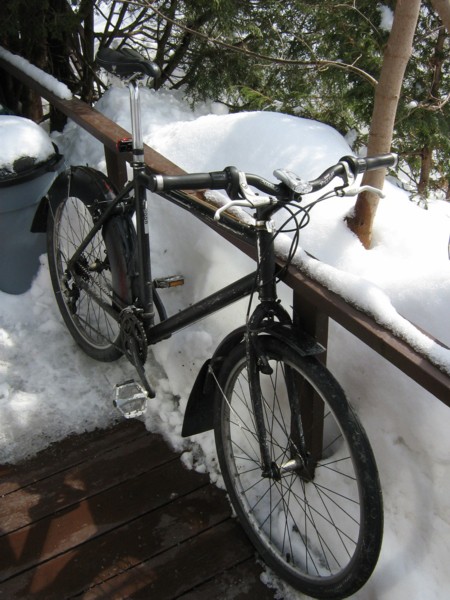
My Winter beater, looking uncharacteristically clean and well-oiled.
After I purchased my Montague, I kept my old Marin mountain bike as a "sacrificial/Winter" bike. Because of the nasty Winter conditions in Quebec City, and the technical difficulties involved in building a good Winter bicycle, I currently resort to having two bicycles: a good one, and a "sacrificial/Winter" bike.
There is nothing special about the Winter bike. It's just assumed that it will be quickly destroyed by the harsh conditions, so it's preferably some piece of junk you picked up in somebody else's garbage, which you fixed up just enough so it will roll, and which you leave outside on the porch all Winter, and regularly clean with a garden hose connected to a hot water outlet you soldered under the kitchen sink, and douse in oil afterward. Despite all those efforts, you still throw out the chain, rear sprokets and brake pads at least once a year.
The second purpose for the Winter beater is when you know you'll be parking your bicycle in a shady part of town. Given a cheap lock, it's pretty theft proof.
That being said, it turns out (for me) that having a Winter bike that is mechanically different from the normal bike is a logistical pain: you need to stock different spare parts, and whatever you learn on how to fix one bike cannot be used on the other one (for example, my old Marin had V-brakes, my Montague had disk brakes, etc.). So the most recent iteration is just buying two identical bicycles on the same day (manufacturers just can't seem to be able to make the same product for very long, so if you want two identical bikes, you probably should buy them the same year).
Airless tires, flat free tires, Greentyre
Not sure where to put this in my article, but I want to write it down to avoid forgetting. I almost purchased airless tires from www.greentyre.co.uk. The price is hefty, but then I started reading reviews on the Internet. The concensus seems to be that rolling resistance is huge and shock absorption is dismal (not only very unconfortable, but also rim-damaging because shock is concentrated in one place), on top of being heavy, expensive and a PITA to install.
If I had an unlimited budget, what bicyle would I build for myself? In other words, how would I satisfy the requirements listed here above?
The basic idea behind my dream bicycle is quite simple: the "pure" must be kept separate from the "impure". There must be an "inside the bicycle" which contains all the delicate and expensive mechanical parts, and an "outside the bicycle" which is the only part actually exposed to "Satan's Winter Sludge". None of this is new, nor technically difficult. Think about the transmission of your car: it just works, year after year, despite swimming in the same sludge that destroys my bicycle's transmission in a few months. The car's transmission is just sealed off from the environment, the gears are constantly lubricated and cleaned by an oil bath, and the oil itself is constantly being pumped through a filter which removes any dirt that might have found it's way in, or any little pieces of metal that might have been abraded from the gears.
I think an extra twist to this basic idea would be required for a bicycle, because the seals between the "pure inside" and the "impure outside" would need to have very low friction. On any human-powered vehicle, every fraction of percent of additional inefficiency is painful. On a car or a motorcycle, there is plenty of available horsepower, so making a seal a bit tighter so the transmission oil doesn't seep out is fine. On a bicycle, I might prefer to have positive internal air pressure, and some oil seepage, rather than the additional friction of a tighter seal. I'm guessing that if some clean air was pumped into the "pure" side, then the natural tendancy would be for oil (and air) to flow out of the "pure" side, and not for water and dirt to flow in.
I'm also guessing that a little manual relief valve for air pressure could be activated when you arrived at your destination, to let the extra air pressure from inside the bicycle blow out. The seals would be barely tight enough to prevent oil seepage with neutral internal air pressure. Maybe this relief valve could be somehow connected to the bicycle lock mechanism, so when you tried to lock up your bicycle, it would automatically relieve the pressure.
The air pressure (and oil spraying mechanism) could be powered by some rear-brake activated pump. Indeed, bicycle brakes are just a way to transform kinetic energy (the cyclist and his bicycle moving forward) into heat (the brake pads rubbing on the brake rotor). All that kinetic energy being wasted with heat production! I'm sure the disk brakes will always be necessary, but a little clutch could be added, to activate the pump under hard braking.
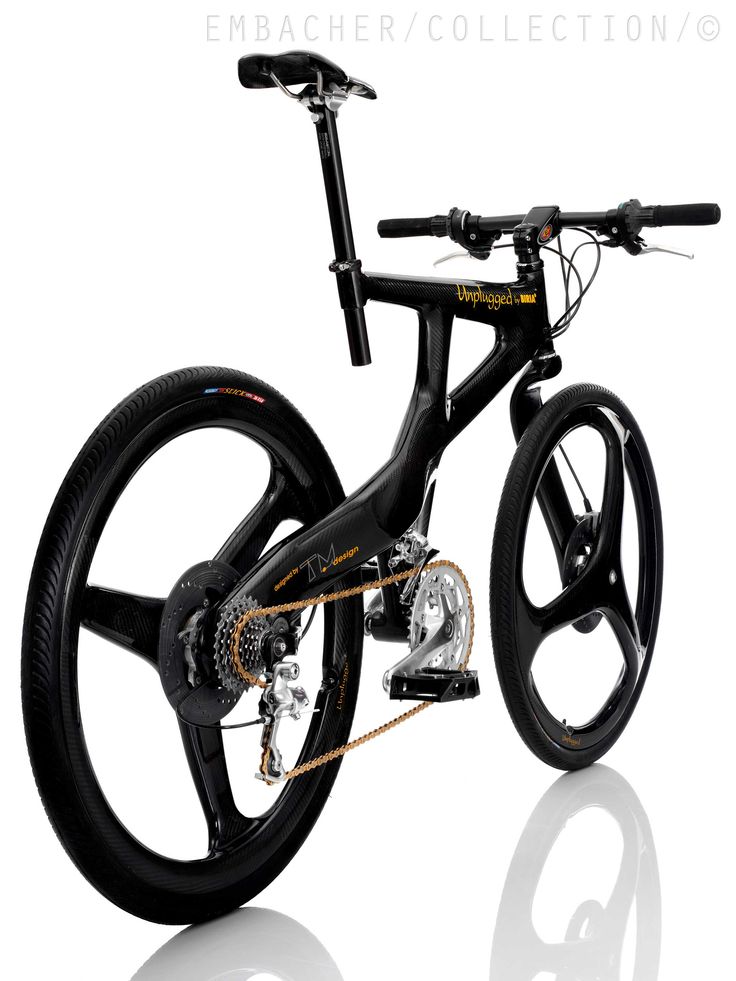
Asymmetric frame with side-mounted wheels on cantilever hubs.
(But bozo designers left all mechanical parts outside!)
[Source: BIRIA Unplugged Tm-Design]
On a bicycle, the mechanisms that need to be protected from the outside world are:
- Front and rear hub bearings (allow the wheels to turn freely);
- Headset bearings (what lets the handlebars turn the front wheel);
- Left and right pedal bearings;
- Bottom bracket (holds the pedal cranks);
- "Transmission" (let's leave it vague for now; it could be an ordinary chain
with two deraillers and chain tension jockey wheels, or a rear hub internal
derailleur, or a fancy motorcycle-style sequential gear transmission, etc.);
- Freewheel (what lets the rider stop pedaling without the pedals banging
into his legs);
- and a few more minor things (brake actuation mechanism, seat tube
height adjustment mechanism, etc.).
Ideally, all these mechanisms would be inside one unique container (in our case the bicycle frame), which would make it a lot easier to keep everything nicely oiled and pressurized. It's possible to have several separate compartments, each with their own oil bath and pressurization mechanism, but let's think out loud with just one compartment, to see if we can make the system as simple as possible.
If we had an asymmetric frame with side-mounted wheels on cantilever hubs, almost all mechanisms listed above could be fairly easily "repatriated" inside one single space inside the frame. (It could be done with a more ordinary frame, but with greater complexity.) Some areas would be harder to reach by the lubrication-pressurization system. For example, the front wheel hub is held far above itself by the pivoting fork. This means the oilpath has to go up to the fork pivot, and then back down to the bottom bracket and transmission, etc. With a bit of plastic tubing and the pump mechanism hinted at above, that could be solvable. The other "remote area" is the pedal bearings. That would require hollow cranks, so the oil could travel from the bottom bracket area, down the cranks, and into the pedal spindles. Here again, not easy, but far from impossible.
A bicycle frame with side-mounted cantilever-hub wheels has many intrinsic disadvantages. The biggest is weight. Far more metal needs to be used to make the frame stiff enough to support a wheel only from one side (the standard bicycle frame is a thing of beauty, an engineering marvel; any attempt to deviate from that standard shape is immediately punished by more weight and less stiffness).
There are some advantages though. The most important being of course the ease with which all mechanical moving parts can be placed inside the frame and lubricated with the same system. But I see another one: the front and rear wheels are now identical, with no connection anymore to either the brakes or transmission. So they are very easy to pop off and replace. On any other bicycle, the rear wheel is always a pain to remove because of the chain (or belt drive, etc.). Also, most braking mechanisms (either "V-brake" or disk brakes) have something on the wheel (either the wheel rims need to accept the brake pads, or the wheel hub has to also hold the disk brake rotor, etc.). With side-mounted wheels, all of that "junk" is removed from the wheels. So it becomes very easy to have different sets of wheels, say one with skinny high-pressure tires on small-diameter rims for city riding, and one on large-diameter rims with huge fat knobby tires (maybe steel-belted for puncture resistance) for more military uses (and perhaps more variations, like metal-studded ice tires, etc.). Also, because of the side-mounting of the wheels, the frame can be designed to accomodate a greater diversity of wheels (for example, huge fat tires which would never fit in a normal frame can now easily fit, if the designer forsees it and makes the cantilever side-mounting hubs just a bit wider than necessary for ordinary city wheels).
There might be other advantages, like the ease with which the rear wheel could be removed and used as a "PTO", a "Power-Take Off" like on a farm tractor. (I'd love to be able to plug my bike into an exercise machine, or an emergency electrical generator.)
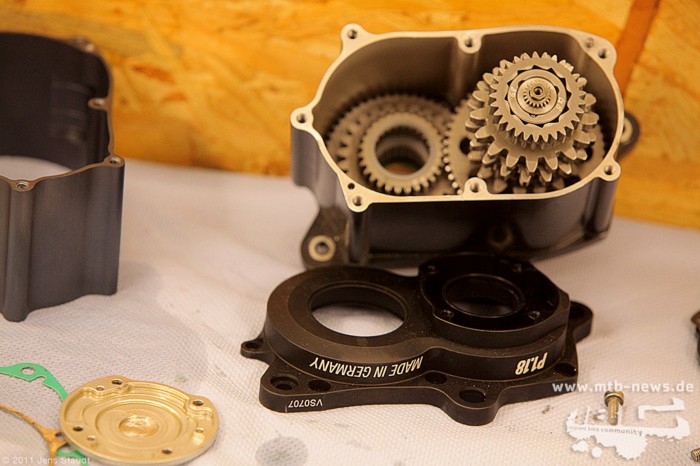
Inside view of a bicycle transmission.
[Source]
Standard external chain derailleurs are an engineering marvel. They are inexpensive, allow huge gear ratios, and are very light. For example, the internal bicycle transmission pictured above, on top of being impossible to find in town and horrendously expensive, weighs around 2.7 kilograms (six pounds), whereas the combined weight of a Shimano XT front and rear derailleur is about 384 grams (0.9 lbs). Right now my "dream bicycle transmission" would just be an ordinary external derailler, with a fully enclosing waterproof casing, and maybe three chainwheels in front, and only two sprockets in back (I rarely use the intermediate speeds, just high, middle, low, and granny gear).
Could something better be designed? I tried, and failed. So I would just have the quick-change wheels, with a fully enclosed ordinary external derailler transmission. For archival purposes, here is a look at a failed attempt:
Why even bother with something other than an external derailleur transmission system? To start, because they are so bloody difficult to fully and hermetically enclose. External chain with front and back derailleur transmissions take up a lot of space (they are not compact), and make it difficult to attach some kind of casing. A second reason could be that they are not that efficient: (i) the chain tensioning jockey wheels add friction at all speeds; and (ii) in many speeds the chain is not straight, i.e. the front and back sprockets are not in line, which "bends" the chain and increases friction; (iii) I think I saw somewhere on the Internet that a higher chain tension (up to a certain point) increases efficiency, something which is impossible with external derailleurs (there must be a permanent "blob of slack chain" kept in reserve by the jockey wheels).
I have never seen a fully enclosed external chain and derailleur system. The only attempts I've found start by getting rid of the derailleurs (in other words, the attempts start by defeat! they start by not trying to enclose the external derailleurs!). Also, the only attempts I've found are not hermetical, so they could never be a true oil-bath bicycle transmission. In other words, if dunked in water and dirt and salt, they would let it all in.
Here is one attempt: no external derailleurs (fail), and you can clearly see the seal around the pedal crank is not hermetical:
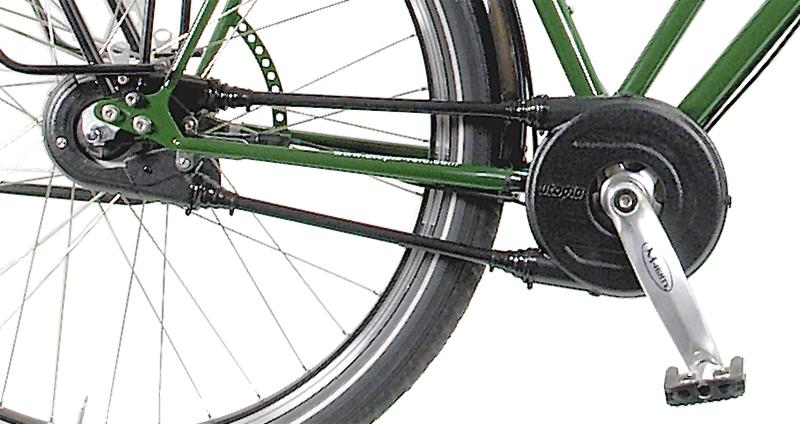
Utopia Velo Kettenschutz.
[Source]
Another attempt: no external derailleurs (fail), but interesting chain pathway:
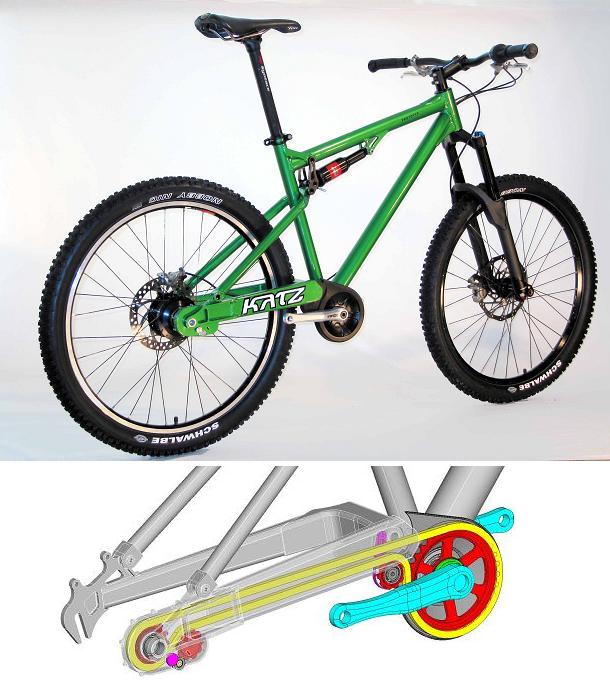
Katz Bikes maintenance-free MTB.
[Source]
Both these attempts use internal hub gears (planetary gears), which are fiendishly complicated, heavy and expensive beasts, less efficient than external derailleurs. They also make the rear wheel much harder to remove and install: (i) the gear-changing cable is no longer connected just to the rear external derailleur, but to the actual hub of the rear wheel, so it must be disconnected to remove the wheel; (ii) for the planetary gears to work, the central part of the hub must be very solidly bolted to the bicycle frame, which means you can't use quick-release wheel attachments, and you must use special torque-cancelling nuts tightened with an old-fashioned wrench; (iii) unless you have a special frame, you have to keep the silly chain tensioning jockey wheels of an ordinary external rear derailleur...
I have briefly tried to imagine an internal transmission that would solve these problems, but have bumped against apparently insurmountable problems. The first one is that you still need a chain! Even if you have millions of dollars to develop a perfect bicycle transmission, you still need to carry that torque to the rear wheel, and the best way to do that is a chain... (There are driveshafts available, but they are apparently by nature quite inefficient, because the torque has to be "turned" at right angles twice.)
The second insurmountable problem is incredibly silly and simple: as soon as you mesh one gear to another, you change the direction of rotation, so you already need three gears in succession!
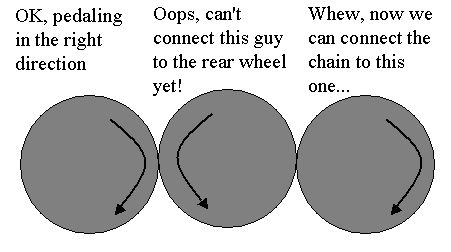
Inevitable rotation inversion with gears.
So "chain (between front and rear sprocket) + minimum of three gears" will always be less efficient than "chain (between front and rear sprocket) + nothing else". I just can't see how to avoid that.
So the man to beat will always be the "fixie" (a one-speed bicycle, with one front sprocket, one back sprocket, and a chain in between, nothing else). The only way to approximate the efficiency of the fixie is to have only two sprockets and a chain between them. To maintain the same efficiency, we cannot have additional junk in the system, like the two chain tensioning jockey wheels. Somehow the front and rear sprockets have to miraculously change sizes, without making the chain longer or shorter.
Keeping the chain the same length might not be that hard. If one sprocket magically shrinks by X number of teeth, and the other magically enlarges by the same X number of teeth, won't the chain remain the same length?
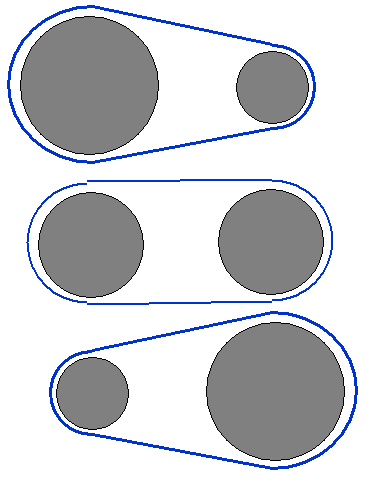
Doesn't this chain remain the same length at three speeds?
The next part is the shape of the chain. We are used to seeing the teeth on the sprockets, and the rollers on the chain, but "teeth" on the chain and rollers on the chainwheels are also possible, a bit like the Gates carbon belt drive:

Gates carbon belt drive.
[Source]
I would make that chain out of steel (it would not be a real belt, because they are too fragile and inefficient), with a smaller pitch than the standard half-inch pitch of normal chains, so the sprockets could be smaller. Maybe 8 mm? (Shimano did try 10 mm many years ago.)
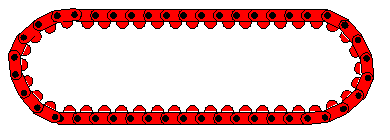
"Jetbelt" steel chain.
Now we need some "magic" so the same sprocket can have different diameters. If the teeth are on the chain, and the pins or rollers are on the sprocket, we can in theory have movable pins on the sprockets.
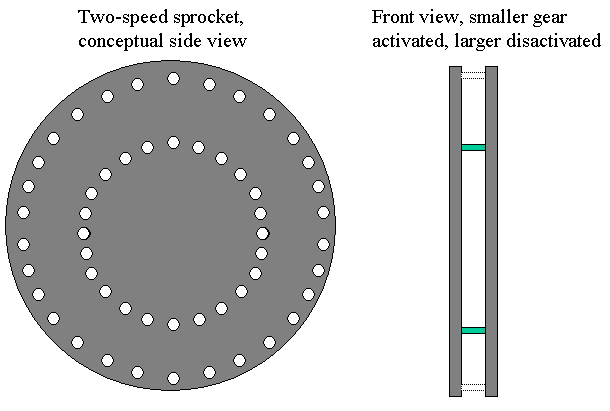
Conceptual two-speed sprocket with moving pins.
How would the pins move? I'm only guessing here, but I'd start by trying some kind of "T"-shaped pin, articulated at the elbow, with some kind of ball détente to keep it either in "down mode" (i.e. with the chain pulling on it) or in "up mode" (swung up and out of the way, so another sprocket diameter can be formed). The articulation of the pin would be "turned into" the direction of torque, so that when in "down mode", the chain would tend to pull the pin down into its seating notches on both plates (because of the freewheel, sprockets never have to sustain torque going backward, so we can make it stronger in one direction only).

One pin illustrated, folded up.
Let's look more closely at an individual pin:
A) A notch is machined in the other plate of the sprocket, to support
the pin under load.
B) Each pin has a "roller" (which is just the usual roller that all
chains have, except since the "teeth" are now on the chain, the rollers
are transferred to the sprockets). I assume the roller would have some
kind of shape or something to keep the chain centered between the sprocket
plates, to avoid having it rub against them.
C) When folded up, the pin would of course be completely out of the way.
D) and E) I don't know, but maybe the gear-changing mechanism could be just a
little inclined plane, that "bumps" the pin up or down, while the plate spins
the pin past it? Bumping the pin into the up or down position would require
energy (provided by the cyclist pedaling), but once the gear change would have
occured, the ball détente on each pin would keep it in its current
position without any addition of energy.
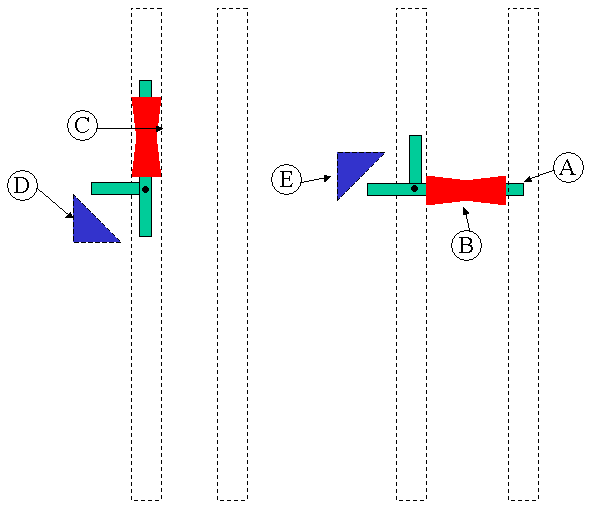
Closeup of one pin, in up and down position, seen from front.
I assume the devil is in the details, and I'm not sure how exactly the chain will behave during gear changes. Since we are trying to keep the chain nice and tight, gear changes become at best a delicate ballet which must be perfectly timed! As far as I can see, the top section of the chain is a fixed length, and under load, so the gear change cannot occur there:
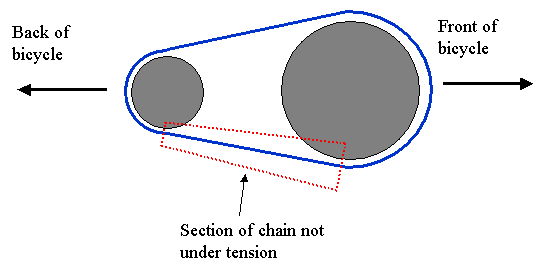
Section of chain where a gear change can occur.
I assume the currently larger sprocket would have to necessarily start to shrink first, and only when the "chain slack" would be available for the other sprocket to grow, could the gears actually change.
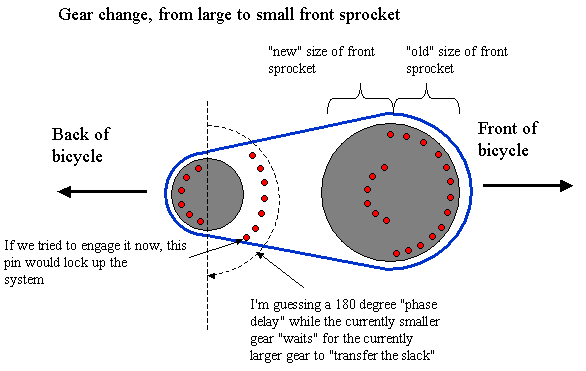
Inevitable "phase delay" when changing gears?
Would this be possible without reintroducing some kind of "chain tensioning jockey wheels", conceptually to accumulate the slack while the currently larger sprocket is being shrunk, then to "feed it back" into the system as the currently smaller sprocket can now begin to grow? I don't know. Maybe a gear change without such jockey wheels could be done, with very careful timing of the activation of the "pin bumps". But that seems awfully prone to total disaster, if any mistake occurs. If jockey wheels are reintroduced, a bit of mechanical trickery could make them intervene only during a gear change (so they would not add friction during normal pedaling).
All in all, very complicated. I would not want it on my bike. A standard old-fashioned external derailler, fully-encased, is much better.
I'm not a mechanical engineer, and I'm not very bright, but it seems that the design of the standard bicycle is quite mature, and hence many things cannot be improved dramatically. Some examples: The general layout (two same-diameter wheels, rider straddling the middle, torque generated with pedals and driving rear wheel, frame composed of triangles made of tubing, etc.). The metal chain seems like the most efficient way to transmit the torque to the rear. Driveshafts are horribly inefficient, and drive belts (as far as I know) also. The hub-and-spoke design of bicycle wheels is an engineering marvel. Indeed, the more I learn about bicycles, the more respect I have for them.
Let's Adore Jesus-Eucharist! | Home >> Varia >> Bachelor's Kit